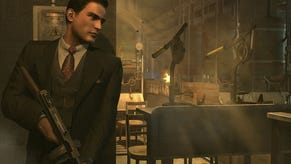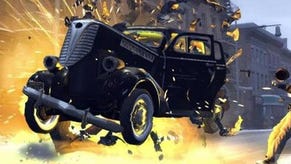Mafia II
Back for hood.
Driving features prominently during your adventures and you'll spend a fair amount of time behind the wheel of one of the 50 vehicles in the game - all of which are approximately 1000 per cent more fun to drive than the hilariously unforgiving ones you might remember (for all the wrong reasons) from the broken-but-brilliant original. Comprised of a fictional selection inspired by the beautifully elaborate designs of the era, any attempt at realism is largely thrown out, replaced by a simple, road-holding handling model that makes it easy to weave in-and-out of traffic at speed, and simple to corner without fear of rolling the damned thing.
In fact, all the maddening restrictions that characterised the original have been well and truly lifted - chief of these being the ultra-strict speed limits. While speed restrictions still play a part in Mafia II, it's nothing like the kind of draconian nonsense you'd routinely have to put up with in the original. For the most part, not only can you put your foot down without instantly attracting attention, when you do you'll be able to outrun the rozzers relatively easily.
As a consequence, simple elements like being able to explore the city don't turn into a gigantic headache as soon as as minor offence occurs. In such situations, you can either accept your fate and take a fine, or remove the speed limiter and roar off into the distance and try and outrun them. Put simply, driving around the gorgeously detailed metropolis is actually fun. You're able to explore all ten miles of the city without petty restrictions, with no area of the map closed off to you.
Gunplay inevitably figures prominently in the Mafia II experience. Once Vito signs up for a life of turf wars and gang retribution, it's not long before you encounter missions where you're taking on entire armies of thugs, armed with your MP40 and Colt 1911. As you might expect, 2K Czech doesn't try to reinvent the wheel, and adopts the standard twin-stick, twin-trigger approach, providing the usual left-trigger-to-aim, right-trigger-to-fire system we're all used to.

With its unusually forgiving lack of weapon recoil or reticule drift, it's apparent from the minute you pick up a gun that the combat has been designed firmly with accessibility in mind. Simple cover mechanics make it easy to duck behind door frames and pillars and then pop in and out of cover by squeezing the left trigger.
You can even quickly move around the side of a cover point once you reach the edge of it, allowing you to seamlessly sidle past objects and get a better angle on your target. This subtle twist on the use of cover also makes it somewhat simpler to take a stealthy approach, assuming that taking on a whole pack of enemies isn't an option.
We didn't play enough of the game to see whether any of the missions give the player a choice in how to tackle them, but it didn't seem likely from the four chapters we got to sample in the preview build. Either way, there's a breezy slickness to all facets of the game, right down to the AI behaviour. Enemies dart in and out of cover and generally make a nuisance of themselves by shifting their position, but they are not superhuman. 2K Czech seems to have gotten the balance right.







